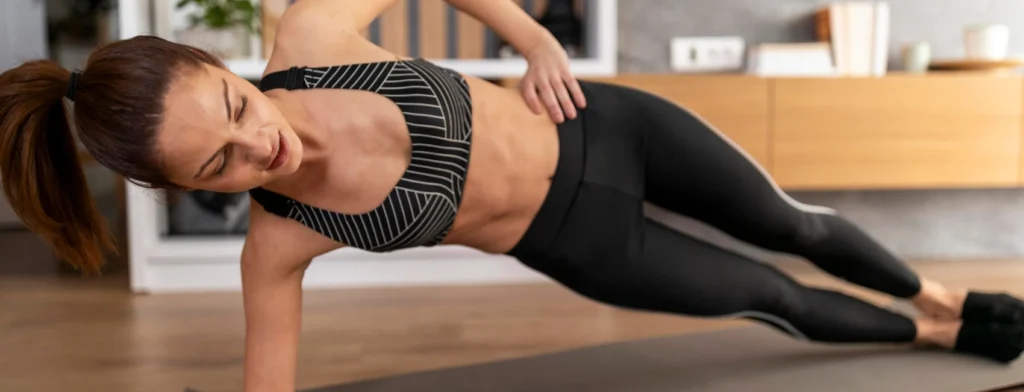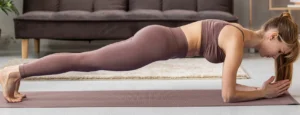Side planks are a challenging and effective exercise that primarily target the muscles of the core, particularly the obliques. Unlike traditional planks that focus on the front abdominal muscles, side planks place emphasis on the muscles along the sides of the torso.
During a side plank, you support your body weight on one forearm and the side of your foot, lifting your hips off the ground to create a straight line from head to toe. This position engages the muscles of the core, including the external obliques and internal obliques. These muscles are responsible for lateral flexion and rotation of the spine, and by working them through side planks, you can strengthen and tone the sides of your waist.
In addition to the obliques, side planks also engage other muscle groups to provide stability and support. The muscles of the shoulders and arms, particularly the deltoids and triceps, work to stabilize the upper body and maintain proper alignment. The glutes, specifically the gluteus medius and minimus, are also activated to help stabilize the hips and prevent sagging.
Furthermore, side planks challenge the muscles of the lower body. The muscles of the hips, including the hip abductors, such as the gluteus medius, tensor fasciae latae, and adductors, are engaged to maintain proper alignment and prevent the hips from dropping.
By performing side planks regularly, you can develop core strength, stability, and endurance. Strengthening the obliques and other core muscles through side planks can improve posture, enhance spinal stability, and contribute to better overall functional movement patterns. Side planks can also help improve balance and coordination, as they require a high level of control and focus.
Side planks can be modified to suit different fitness levels by adjusting the level of difficulty or adding variations. For instance, you can increase the intensity by lifting the top leg, performing side plank rotations, or incorporating movements such as hip dips or leg raises. These modifications can further challenge the core muscles and provide additional benefits.
Side Planks – Instructions & Steps
- Using your elbow or palm of your hand, life yourself off the ground on one side placing your legs together so they form a straight line
- Hold this position, squeezing your buttocks and tightening your core
Benefits of Side Planks
Side planks offer numerous benefits for the body, particularly in terms of core strength, stability, and overall fitness. As with any exercise, it’s important to maintain proper form and listen to your body. Start with shorter holds and gradually increase the duration and intensity as your strength improves. Here are some key benefits of incorporating side planks into your exercise routine
Core Strengthening
Side planks primarily target the muscles of the core, including the obliques, which are responsible for lateral flexion and rotation of the spine. By engaging and strengthening these muscles, side planks help to develop a strong and stable core, improving overall functional movement and enhancing performance in other activities and sports.
Improved Posture and Spinal Stability
Side planks help to promote better posture by strengthening the muscles that support the spine and torso. By targeting the obliques and other core muscles, side planks help to stabilize the spine and improve spinal alignment, reducing the risk of postural imbalances and associated discomfort or pain.
Increased Balance and Coordination
Performing side planks requires balance and stability, as you lift your body weight and maintain proper alignment. Regular practice of side planks can help improve balance and coordination by enhancing proprioception and body awareness.
Enhanced Hip and Pelvic Stability
Side planks engage the muscles of the hips and pelvis, including the gluteus medius and minimus, which are important for hip stabilization. Strengthening these muscles through side planks can improve hip stability, reduce the risk of hip and lower back injuries, and enhance overall functional movement patterns.
Core Endurance and Functional Fitness
Side planks are an isometric exercise that requires sustained contraction of the core muscles. By holding the side plank position for an extended period, you can improve core endurance, allowing you to better maintain stability and support during daily activities and other exercises.
Variety and Progression
Side planks can be modified and progressed to suit different fitness levels and goals. You can add variations such as lifting the top leg, performing hip dips, or incorporating side plank rotations to increase the challenge and target different muscle groups. This versatility makes side planks a valuable exercise that can be tailored to individual needs and preferences.
Time Efficiency and Convenience
Side planks can be performed anywhere and require minimal space or equipment. They can be incorporated into a quick workout routine or added as a complementary exercise to other workouts. Side planks offer a time-efficient way to engage the core and reap significant benefits in a short amount of time.
More About Side Planks
Side planks are not typically considered compound exercises. They are a form of isometric exercise that primarily targets the muscles on the side of the body. Side planks are typically performed by supporting your body weight on one forearm or hand, with your body in a straight line and facing sideways.
During side planks, the following muscle groups are engaged:
- Obliques: The side muscles of the abdomen, which are responsible for lateral flexion and rotation of the spine.
- Transverse abdominis: The deep core muscle that helps stabilize the spine and pelvis.
- Gluteus medius: Located on the side of the hip, this muscle helps to stabilize the pelvis during the side plank.
- Hip abductors: These muscles on the outer hip help lift and support the leg in side plank positions.
- Shoulder muscles: The muscles around the shoulder joint are engaged to stabilize the upper body.
Side planks can be beneficial for strengthening the core, particularly the obliques, and improving lateral stability. They are also useful for addressing muscle imbalances on one side of the body. However, since side planks are primarily an isometric exercise that involves static muscle contractions, they are not classified as compound exercises.
To engage in compound movements that work multiple muscle groups simultaneously, exercises such as squats, deadlifts, bench presses, and push-ups are more appropriate choices.



